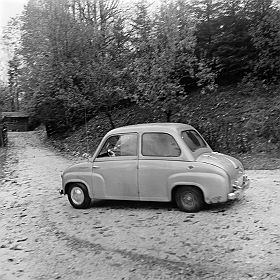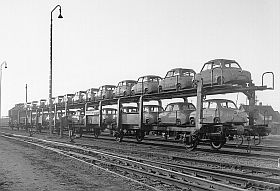With the Goggomobil came great success
The good sales success of the Goggo scooter could not hide the fact that the two wheeler boom of the postwar years could not last forever. The income of the people increased and therefore also the demand they put on their transportation. The trend was inevitably towards the small car and more or less successful manufacturer of this vehicle grew around the world like mushrooms. Hans Glas also recognized this opportunity and ordered in 1953 to develop such a vehicle. It was decided not to offer their customers an odd-shaped driving machine à la Messerschmitt or Fulda Mobil, but a real car, however just a miniature version. Looking at what the competition did could not completely be ignored and so in 1954 the first prototypes, despite the promised normal pontoon form, a front door like the Iso or later the BMW Isetta was used. This idea however was quickly dropped.

In early 1955 the small car, now baptized "Goggomobil," came finally of the production line and the success of this pretty vehicle was so great, that in spite of the 150 cars built daily, the demand for this car could not be covered. The sedan with a 250 or 300 cc two-stroke twin cylinder in-house designed engine was followed by variants of 400 cc, a coupe and a small van. Building licenses went to Spain and even to Australia. Within a short time the GLAS Goggomobil became the world's most successful vehicle of its kind with a total production at the end of over 280,000 copies. It was inevitable that, in view of this stunning track record GLAS soon had the desire for something higher. In the meantime the company had grown to up to 4,000 employees and the revenue from 1955 to 1959 had more than quadrupled. In 1958, the range was expanded with a larger vehicle powered by a 600 or 700 cc four stroke engine. This "Big Goggomobil," later called the GLAS Isar, was also offered as an estate version, did not produce the sales as the small Goggomobil. The majority of car buyers looked now for cars of the middle class range and therefore also GLAS decided to be there as well. Andreas Glas and chief designer Karl Dompert set about to break into the class of larger vehicles.
It was inevitable that, in view of this stunning track record GLAS soon had the desire for something higher. In the meantime the company had grown to up to 4,000 employees and the revenue from 1955 to 1959 had more than quadrupled. In 1958, the range was expanded with a larger vehicle powered by a 600 or 700 cc four stroke engine. This "Big Goggomobil," later called the GLAS Isar, was also offered as an estate version, did not produce the sales as the small Goggomobil. The majority of car buyers looked now for cars of the middle class range and therefore also GLAS decided to be there as well. Andreas Glas and chief designer Karl Dompert set about to break into the class of larger vehicles. By the end of the nineteen fifties, plans were discussed to combine GLAS, BMW and the Auto Union into the "Bavarian Car Works." The driving force behind this idea was the Bavarian Prime Minister Alfons Goppel, which in this way wanted to save the for survival fighting Bavarian Motor Works (BMW) and the troubled car company in Ingolstadt (Audi). But Hans Glas, now 69-year old and with serious health issues, was non-receptive to this change, so nothing materialized from this idea.
By the end of the nineteen fifties, plans were discussed to combine GLAS, BMW and the Auto Union into the "Bavarian Car Works." The driving force behind this idea was the Bavarian Prime Minister Alfons Goppel, which in this way wanted to save the for survival fighting Bavarian Motor Works (BMW) and the troubled car company in Ingolstadt (Audi). But Hans Glas, now 69-year old and with serious health issues, was non-receptive to this change, so nothing materialized from this idea.
Hans Glas GmbH company history - With the Goggomobil came great success
Inhalt
Page 2 of 3



